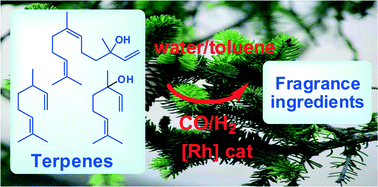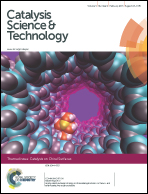Synthesis of fragrance compounds from renewable resources: the aqueous biphasic hydroformylation of acyclic terpenes
Abstract
The rhodium-catalyzed hydroformylation of acyclic terpenic compounds, i.e., β-citronellene, linalool and nerolidol, was performed in a water/toluene biphasic system. The addition of the cationic surfactant cetyltrimethylammonium chloride remarkably increased the reaction rates, with the surfactant effect being substrate dependent. A water-soluble phosphine ligand was used to immobilize the rhodium catalyst in water, an environmentally benign solvent, whereas non-polar products were collected in the organic phase. A complete phase separation was easily achieved by switching the magnetic stirrer off and cooling the mixture to room temperature. Linalool and nerolidol gave cyclic hemiacetals with excellent stereoselectivity, whereas the hydroformylation of β-citronellene resulted in two isomeric aldehydes with a linear-to-branched product ratio of approximately 85/15. Several fragrance compounds with pleasant sweet floral and woody scents were obtained in high yields through a simple and green one-pot procedure starting from the substrates easily available from natural bio-renewable resources.


 Please wait while we load your content...
Please wait while we load your content...